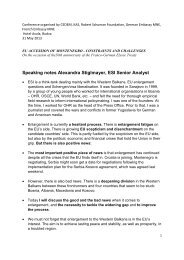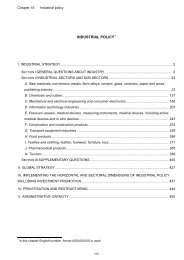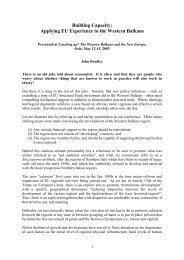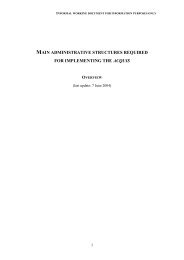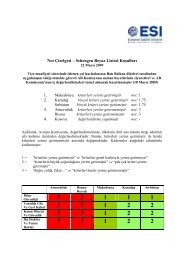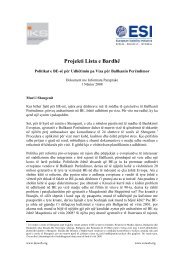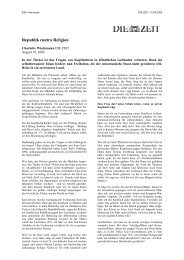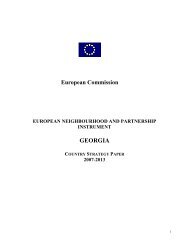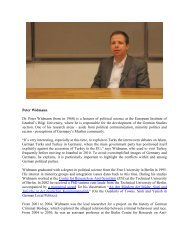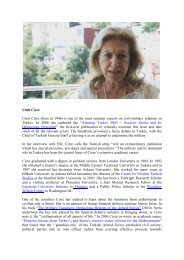Strategy for integrated border management
Strategy for integrated border management
Strategy for integrated border management
You also want an ePaper? Increase the reach of your titles
YUMPU automatically turns print PDFs into web optimized ePapers that Google loves.
<strong>for</strong>mer Yugoslav republics is not satisfactory, and on a number of crossings there is<br />
no infrastructure at all, no electricity or a telephone line, no water or sewerage.<br />
Lack of adequate infrastructure at <strong>border</strong> crossings impedes the work of <strong>border</strong><br />
services. However, despite this defect, there are no clearly defined common<br />
infrastructure requirements, ways of maintaining them, or the solution <strong>for</strong> the matters<br />
concerning property relations.<br />
Traffic infrastructure at all <strong>border</strong> crossings with <strong>for</strong>mer Yugoslav republics is not<br />
satisfactory, evinced in a small number of lanes, bad access roads, and complicated<br />
technology of traffic flow.<br />
It is necessary to secure adequate standardised infrastructure required <strong>for</strong> the work<br />
of all services located at a <strong>border</strong>. The matters concerning property relations and<br />
<strong>border</strong> crossings <strong>management</strong> should be regulated in a unified way.<br />
Equipment at most <strong>border</strong> crossings is obsolete and does not meet basic needs of<br />
modern control and security of <strong>border</strong>s, and at some <strong>border</strong> crossings there is no<br />
equipment at all. Each service at a <strong>border</strong> crossing uses its own equipment.<br />
Approach of common use of equipment contributes to a more efficient work of <strong>border</strong><br />
services, heightens their optimal work and decreases cost.<br />
It is necessary to define the property rights at the <strong>border</strong> crossings since the State<br />
should be the owner. For the purpose of rationalising procedures of acquiring and<br />
use of financial means, it is necessary to define common infrastructure needs, and<br />
requirements <strong>for</strong> in<strong>for</strong>mation technology and equipment.<br />
Strategic goal of <strong>border</strong> services is to achieve the level of technical and technological<br />
equipment of all activity segments, which will facilitate fulfilment of set tasks referring<br />
to <strong>integrated</strong> <strong>border</strong> <strong>management</strong>, in a way which is adequate to the most modern<br />
practice of <strong>border</strong> services in the European Union.<br />
8.11. Budget<br />
All <strong>border</strong> services are financed by the budget of the Republic of Serbia, while the<br />
funds <strong>for</strong> duties <strong>for</strong> which customs, veterinary and phyto-sanitary inspection are<br />
authorised are provided in Allotment Chapters of bodies that they are part of, as they<br />
are indirect users of those resources. Duties of <strong>border</strong> police, as an organizational<br />
part of the MoI, are financed by allotment inside the MoI.<br />
The basic defect is that the <strong>border</strong> services define individually their own needs<br />
related to work at <strong>border</strong> crossings, i.e. there is no plan <strong>for</strong> a unified acquisition.<br />
In the last few years, in the field of <strong>integrated</strong> <strong>border</strong> <strong>management</strong>, a move <strong>for</strong>ward<br />
was made owing to donors’ recommendations, and also due to training and donated<br />
equipment. Several big pilot investment projects provided equipment <strong>for</strong> <strong>border</strong><br />
services including: infrastructure and structures at <strong>border</strong> crossings, surveillance<br />
systems, security of the green and blue state <strong>border</strong>s, <strong>integrated</strong> system of <strong>border</strong><br />
control, and a unified data basis. Also, training of cross-<strong>border</strong> police and customs<br />
servicepersons in subjects such as <strong>border</strong> control, trafficking, and trans-<strong>border</strong><br />
control is provided.<br />
However, in order to improve development of <strong>integrated</strong> re<strong>for</strong>m strategies and to<br />
realize objectives of priority, the relevant ministries whose competence is to manage<br />
<strong>border</strong>s require additional financial, material, and technical aid. Analysis of sectors’





